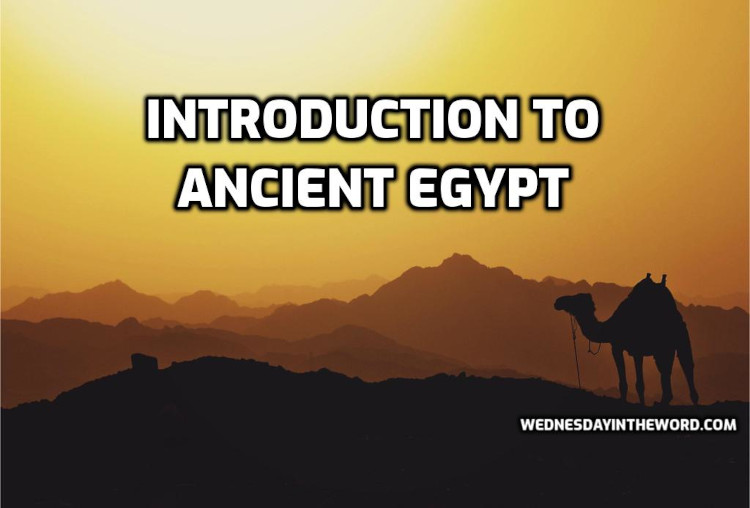The first third of the book of Exodus takes place in Egypt. The Israelites had lived in Egypt for 400 years and were steeped in Egyptian culture. The cultural and historical setting of Exodus is ancient Egypt. Here’s a brief introduction.
The land of Egypt
Egypt developed a civilization early around 3000-2800 BC. The land was blessed with 5 remarkable features:
- Lots of water from the Nile River while being in a desert.
- Because of the long growing season, they could harvest 2-3 crops per year.
- Gentle regular annual flooding that deposited fresh silt upon the land and fertilized it.
- Easy transportation: they could ride the current of the Nile north and let the winds fill their sails to take them south.
- They were protected all around by deserts making invasion difficult.
Ancient Egypt online: Maps
Ancient Egypt online: Nile River
Government
- The government depended on the Pharaoh (king) and agriculture.
- The Pharaoh appointed the other government officials and they took their orders from him.
- Agriculture was the foundation of their economy.
- People paid taxes to the government in crops, livestock, jewelry and gems.
Note: Due to modern discoveries, some scholars argue that the dates of Egypt’s kingdoms are off by centuries and need to be shifted up. This would be a huge shift since the Egyptian chronology underpins the dating of many other ancient cultures and events.
Old Kingdom (2575-2150 BC)
- Two kingdoms developed in Egypt: one in Upper Egypt and one in Lower Egypt.
- The two unified forming the Old Kingdom. This is the period when they built the great pyramids and practiced the art of embalming.
- Dynasties: 3rd – 6th.
- The ancient Egyptians were polytheistic and believed their king was a god. Their society was permeated with religion.
- There were 700 gods and goddesses, and many were combined to create new deities.
- Amun Ra (the Sun God) and Isis often held the supreme position in the hierarchy of gods.
- Egypt became a world power spreading their cultural influence throughout the ancient near east.
- 2600 BC: Pyramid of Djoser built, first known large-scale stone building.
- Menkaure’s Pyramid built during this period, earliest use of carved granite.
- Red Pyramid, first smooth-sided pyramid.
- 2580 BC: Great Pyramid of Giza built. Tallest structure at the time.
- They had a smoothly functioning, centralized government which highly taxed the people.
- Eventually, overspending brought instability and the poor rebelled, taking the property of the wealthy.
- This lead to about a century of chaos and instability known as the First Intermediate Period.
First Intermediate Period (2125-1975 BC)
- Dynasties: 7th-11th
- Unification of Egypt fell apart.
- No central government.
- Weather changes stopped the flooding of the Nile and caused years of famine.
Middle Kingdom (1975-1640 BC)
- Egypt re-emerged as a world power out of this chaos in what is known as the Middle kingdom.
- Dynasties: 12th-13th
- 2055 BC: Mentuhotep II reunited Egypt.
- Under Amenemhat III’s 45 year reign, the Valley of the Kings was used.
- They had an aggressive foreign policy, conquered Nubia, and developed political and economic ties with Canaan and Syria.
- 1878 BC: Senusret III attempts to extend Egypt, begins military campaigns to Nubia.
- They recommenced building the pyramids and tombs.
- Unrest starting developing leading to another period of chaos called the “Second Intermediate Period.”
Second Intermediate Period & Hyksos invasion (1630-1520 BC)
- Dynasties: 14th-17th
- Egypt unification fell apart at the start of the 14th Dynasty.
- No central government.
- The Hyksos — a people from the north, the land of Canaan — invaded, conquered and controlled Lower Egypt for a century.
- Hyksos kings ruled in the North (approximately 1650-1550 BC) and settled in the eastern Delta.
- Eventually, the 17th Dynasty reunites Egypt and defeats the Hyksos and drives them out of Egypt. They disappear from history.
- Expulsion of the Hyksos
New Kingdom (1539-1075 BC)
- The New Kingdom was a time of stability.
- Dynasties: 18th-20th
- They led expeditions to Canaan and Nubia
- Reign of Hatshepsut, first female pharaoh.
- Reign of Akhenaten: Built a new capital called Akhetaten and Akenaton introduced monothesim (1379-1362 BC).
- Reign of Horemheb, focused on re-establishing the Egypt that existed before Akhenaten.
- Valley of Queens made, though some wives were still buried with their husbands.
- Reign of Ramses II, ruled for 67 years and had numerous temples built, such as Abu Simbel.
- 1258 BC: World’s earliest known peace treaty created.
- By 1200, Egypt had ceased to be a world power.
- The Pharoahs created a standing army and military positions, as opposed to using conscripted people.
- Egyptian Empire and Balance of Power, ca. 1400 BCE
- The Egyptian Empire (1450 B.C.)
- Ancient Near East
- Ancient Egypt Online: The History of Egypt
- Ancient Egypt Online: Timeline
Bible Study Resources: Exodus
When did the Exodus happen?
More: Introduction to…
Photo by Mariam Soliman on Unsplash

